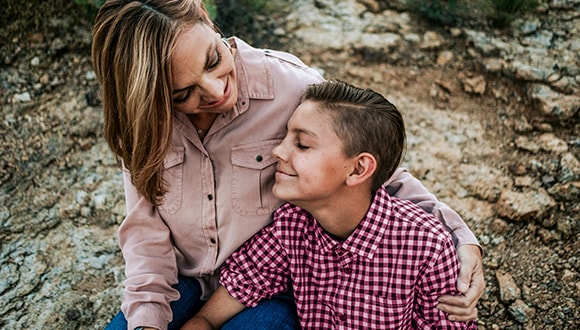How to talk to kids about gender identity
Published February 2024 | 5 min read
Expert contributor Dr Marny Lishman, psychologist
Words by Jo Hartley
Navigating the complexities of gender identity can be challenging for families. So how can we support our kids to be confident in their own skin?
While most parents feel comfortable talking to their children about a wide range of issues, the topic of gender identity can feel like stepping into uncharted territory.
But no matter how confronting or confusing, talking openly and honestly with your child about their gender identity can make it easier for everyone to understand and safely explore what’s involved.
What is gender identity?
Gender identity refers to an individual's sense or understanding of their own gender, which may align with or differ from the gender assigned to them at birth.
Gender identity encompasses how someone personally experiences and expresses their gender. This can include identifying as male, female, non-binary, gender fluid or a combination of these identities.
For some people, their gender identity differs from their assigned gender, and they may choose to identify as transgender. This could mean being designated as male at birth but identifying as a female – or vice versa.
Almost all children begin expressing their gender identity at around two to three years of age, either through their behaviour or their appearance.
In Australia, about 1.2% of school children (about 45,000 children) are thought to identify as transgender. The number of referrals to Melbourne’s Royal Children's Hospital Gender Service has grown considerably in recent years, with around 800 new referrals in 2021, compared with around 250 in 2018.
Non-binary versus transgender
Non-binary is the term used by people who feel their gender cannot be defined as either male or female. Non-binary individuals may identify as a combination of both genders or as neither.
People who identify as non-binary may use pronouns such as they/them. Transgender is a term used to describe people whose gender identity is different from their gender as designated at birth.
What is gender questioning?
"Gender questioning is when an individual is trying to determine what gender or even what sexual orientation they may be," explains psychologist Dr Marny Lishman.
"This questioning might be going against what society is presuming them to be, and therefore they’re wondering whether that’s correct for them."
Signs that your child may be gender questioning include:
- asking more gender-related questions, such as why they have to wear certain clothes or go to a certain bathroom
- asking questions about the opposite gender to understand more about it
- being firm that they’re not their prescribed gender
- wanting to explore or experiment with being another gender
- asking to be treated like another gender
- wanting to go to the toilet in a way that’s associated with a different gender
- expressing frustration at certain characteristics such as breasts
- being anxious.
Providing early support can significantly impact the wellbeing of transgender and gender-diverse children. This support can promote better long-term mental health and reduce the likelihood of tough times.
"Presuming what your child's identity is and what their needs are can be very dismissive," says Dr Lishman. "It’s important to have open and honest conversations about how they’re feeling and what they need at home and at school.
"Being supported by others is fundamental for them to feel comfortable, included and not disadvantaged."

What is gender dysphoria?
Gender dysphoria is the feeling of discomfort, unease or distress that can be experienced by people whose gender identity doesn’t match what was assigned to them at birth.
Dr Lishman notes that children who are struggling with gender dysphoria may:
- ask questions about their gender
- become upset if people call them a specific gender that they don’t identify with
- not feel good about themselves
- ask to be referred to by a different pronoun
- become withdrawn and anxious or show signs of depression
- start hiding their body underneath baggy clothes.
If your child is experiencing gender dysphoria, it's important to ensure they feel supported through unconditional love, acceptance and open communication about their feelings.
"Actively listen to your child to understand them," advises Dr Lishman. "Ask questions, use empathy and be non-judgemental.
"Create a loving, safe and supportive space for them to find out who they are without consequence and don’t push too hard for answers. They may be confused and need to time to think."
For some children, gender diversity behaviour may only be temporary. However, it's important they’re supported while they navigate these feelings.
Gender identity: important terms to know
- Transgender – a person's gender identity doesn’t match their physiological gender as
designated at birth. - Non-binary – a person does not identify as male or female (they may identify as a mix of genders or as neither).
- Gender fluid – a person shifts between gender identities.
- Agender – a person doesn’t identify with any gender.
How to support your child
If your child is exploring their sense of gender identity or showing signs they may be struggling with gender dysphoria, it’s important to open up a conversation about how they’re feeling.
- Let them know you're available to talk and listen when they’re ready.
- Tell them you're there to support them.
- Validate their feelings.
- Encourage them to take as long as they like in finding out what their gender identity is.
- Be curious yourself and ask your child questions to allow them to make sense of it themselves.
Here, Dr Lishman shares her advice on how to have a conversation with your child in the following scenarios.
Scenario #1: Your child is struggling with feelings of confusion about their gender and is unsure if they identify as male or female.
How to raise the topic: It can be hard for your child to express their feelings when they're confused, but it's important to let them know that you're always available to talk. Dr Lishman says parents should try to use their child's questions to drive the conversation, take it at their pace and stay open minded.
Try saying this: "It's common to feel confused about gender, and I'm always here to chat about this and support you. Let me know what information you’d like to find out so we can learn more together. There’s no rush for you to make any decisions."

Scenario #2: Your child is worried about expressing their identity at school.
How to raise the topic: Your child may feel overwhelmed when it comes to expressing their identity in the school environment. They may be worried about things such as which toilet to use, which uniform to wear and how other students may treat them. Dr Lishman suggests having regular open conversations about school to quickly identify any specific concerns.
"Ask them if they have any overall thoughts, concerns or suggestions and ask them if there’s anything you can do to support them," she says.
Try saying this: "How about we chat with the school about how you're feeling and see what suggestions they come up with to help address your concerns and then you can decide what makes you feel most comfortable."
Scenario #3: Your child wants other family members and friends to recognise their gender identity but doesn't know how to start the conversation.
How to raise the topic: Your child may fear judgement and feel uncomfortable about broaching the subject of their gender identity with people outside of their immediate family. Let them know you’re there to support them in whatever way they need.
Dr Lishman says parents can encourage their child to prepare for a conversation about their gender identity by thinking about how they’re feeling, the reasons they want people to know and how they want to be treated.
Try saying this: "What would make you most comfortable? What is it you really want to say? Would you like to talk to them by yourself or would you like me to come with you and we can discuss it all together."
Managing your feelings as a parent
It's common for parents to experience a variety of emotions about a child exploring their gender identity, including confusion and grief. You might ask yourself: Why is this happening? Did I do something wrong? Have I lost my son or daughter?
But as your understanding grows, Dr Lishman says many of these emotions often fade.
"Often it's through not knowing enough that we can become fearful," she says.
"Continue researching, learning as much as you can and talking to your child. If it helps, visit your GP or reach out to a professional organisation for support. Your mental health is as important as your child's."
If you need to speak to someone about your feelings, it's important to seek help so you can support your child in the best way possible. To help your teen manage big changes and feelings, the free annual HealthyMinds Check-in* with PSYCH2U now includes access to specially trained psychologists for teens aged 12 to 17. Teens can discuss school stress, social challenges or general mental health concerns and be directed on where to get help.
Resources available to support you and your child
- ReachOut.com – online information and support for mental health.
- headspace – support and information on mental health and LGBTIQA+ diversity.
- Minus18 – information for young people on gender and sexuality.
- Beyond Blue – support for mental health.
- Kids Helpline – a confidential phone and online counselling service for young people.
- Parents of Gender Diverse Children – support and information for parents of trans and gender-diverse young people.
Helping your kids with their big feelings
HCF members who have hospital or extras cover can access Calm Kid Central^, an online educational and support program helping kids aged four to 11 manage their big feelings and emotional challenges. The program provides confidential access to an experienced child psychologist who can answer your questions within 48 hours, as well as tools and resources to help you support your child. Check out the FAQs page to find out if you’re eligible.
RELATED ARTICLES
Talking kids’ mental health
Keeping an eye on your kids’ mental health is essential. Learn how to spot signs of anxiety or depression and have an open conversation with your kids.
How to deal with peer pressure
Peer pressure is a normal part of growing up. We asked experts for their tips on how to spot the signs and help your kids navigate through it.
Anxiety in children
Every child feels scared or stressed sometimes. But more serious childhood anxiety can affect the whole family. Here’s how parents can help.
What is body image?
Our perception of how we look influences how we feel. But how important is having a good body image? And what kind of impact can it have on our health?
IMPORTANT INFORMATION
* Eligibility criteria applies. For more information see hcf.com.au/mental-support
^ Excludes Accident Only Basic cover and Overseas Visitors Health Cover.
This communication contains information which is copyright to The Hospitals Contribution Fund of Australia Ltd (HCF). It should not be copied, disclosed or distributed without the authority of HCF. Except as required by law, HCF does not represent, warrant and/or guarantee that this communication is free from errors, virus, interception or interference. All reasonable efforts have been taken to ensure the accuracy of material contained on this website. It’s not intended that this website be comprehensive or render advice. HCF members should rely on authoritative advice they seek from qualified practitioners in the health and medical fields as the information provided on this website is general information only and may not be suitable to individual circumstances or health needs. Please check with your health professional before making any dietary, medical or other health decisions as a result of reading this website.